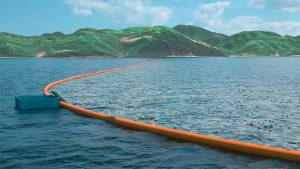
In the USA, only 8% of plastic is recycled. The rest ends up in landfills, or it remains uncollected and can wash into the sea, causing ocean pollution. It’s estimated that there are 5.25 trillion pieces of plastic in the ocean, with 8 million tons being added every single year.
Why do we need to clean up the ocean?
Ocean pollution can be very harmful to creatures that live there as they can get tangled in it, causing severe damage or even death.
Plastic doesn’t break down very easily, so each piece will stay in the ocean for decades. After a time, these pieces break down into small particles called microplastics. These are often eaten by fish, seals, turtles, and other marine animals as they mistake them for food.
As larger predators eat the smaller fish, the plastic pollutants and harmful chemicals move up the food chain, leading to poisoned marine life, birds, and other animals who live off the sea. Chemicals that can be released from plastics include mercury and lead. If we humans eat large quantities of fish contaminated with these, we are potentially risking getting sick.
There are other negative consequences of plastic ocean pollution. This includes damaging or confusing navigation systems used on boats and ships and damaging fishermen’s nets and equipment.
The Great Pacific Garbage Patch
Due to the way the ocean currently moves the water, ocean areas naturally collect large amounts of plastic and other waste. The largest of these is known as the Great Pacific Garbage Patch. Most of the garbage collects under the water’s surface – up to 90 feet deep in places – making it hard to realize its size. Estimates range from between 700,000 square miles (the size of Texas) – 15,000,000 square miles.
All of this trash is having harmful consequences on the sea life there. Plankton, which so many fish (and other marine animals such as whales) depend on as their only food source, is slowly dying as it doesn’t get enough energy from the sun due to the litter blocking it out.
A decline in plankton leads to a decline in fish, which may lead to a decline in the predators that eat those fish – and the effect continues up the food chain.
Here are some photographs of the Great Pacific Garbage Patch. The video does contain some pretty hard-hitting images, so be warned. It was first uploaded to YouTube four years ago. Unfortunately, the Patch has got worse since then.
Introducing the ‘The Ocean Clean Up Project’
The Ocean Clean Up Project was founded by Boyan Slat when he was just 17 years old. He saw the potential to use the naturally occurring ocean current to collect the plastic and trash from the Great Pacific Garbage Patch to be removed and recycled.
In 2012, Slat hosted a TEDx talk where he introduced his concept. His speech went viral and was watched millions of times, leading to a successful crowdfunding campaign, which raised $2.5 million to start work on the project.
It’s estimated that the project could completely clear the Great Pacific Garbage Patch in twenty years.
How you can help to reduce plastic pollution
It’s not just inventors and scientists who can help to clear the ocean of debris. You can play your part too.
There are several simple ways in which you and your family can help to reduce plastic and other pollution in the ocean:
Take litter home with you.
When visiting the beach or other water-based attractions such as lakes or rivers, take all of your trash home with you. Never leave anything behind; dispose of it safely when you are back at home.
Limit your use of plastic bottles
Every year almost 20 billion plastic bottles are thrown in the trash. Curb your use of plastic by purchasing a reusable bottle rather than buying plastic bottles of water when you are out. If you prefer the taste of bottled water, find a reusable bottle with a built-in filter, and you’ll get the same taste from your tap water. This will save you money in the long-term too!
Limit your use of plastic
Plastic is often seen as a cheap yet highly convenient purchasing choice. The “use one then throw away” mentality has become engrained in our culture, and that’s not good news for our environment and oceans. Try to limit your use of plastic by investing in reusable items and staying away from “throw-away” plastic items such as plastic cutlery, tablecloths, coffee cup lids, and grocery bags.
Recycle your plastics
Recycling your plastic means less will end up in landfills, which is great for our planet. Plastic recycling is essential to limit the number of landfills. It also means that fewer raw materials will be needed for plastic production.
Stay away from microbeads.
Microbeads are tiny plastic beads that can be added to shower and bath products to give an exfoliating effect on the skin. Because the beads are so small, water treatment facilities can’t filter them out, so they can end up back in the water system and oceans where they get mistaken for food by fish and other marine life.
Last update of the article: 01/30/2021.
What steps do you reduce your plastic usage? Are there any tips that you could share with our readers to help them live a reduced-plastic lifestyle? Please share your stories in the comments below.
Image credit: Erwin Zwart/The Ocean Cleanup

About the Author
James is your friendly neighborhood content writer here at the Green Living Blog. With a passion for all things sustainable, he’s your go-to guru for everything eco-friendly. Armed with a treasure trove of wisdom about sustainable living, recycling, and environmentally conscious practices, James is on a mission. He’s here to make sure you not only protect your family but also keep Mother Earth smiling. 😊🌎 When he’s not busy sharing eco-friendly insights, James can often be found teaching his cat that compost bins make the purr-fect hideaway. 🐱♻️ Join James on his quest to uncover the secrets of defeating wasteful habits while leaving the lightest footprint on our precious planet’s ecosystem.
